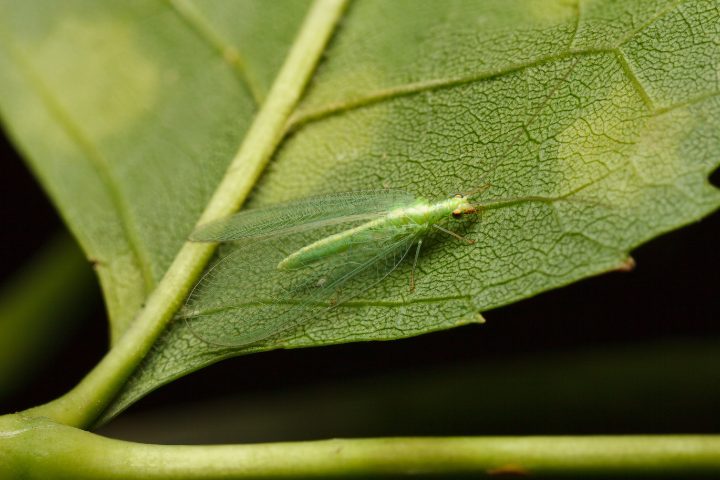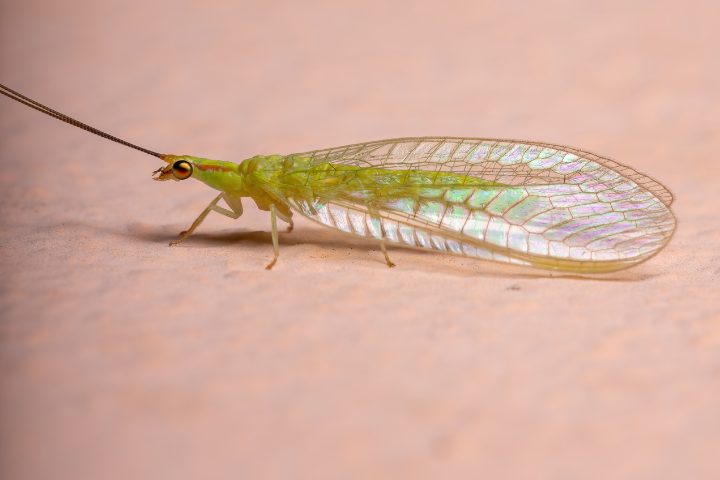Most humans instinctively fear insects, and a green-colored fly with netted wings might look scary to most people. But are green lacewings harmful to us in any way? Let’s find out.
[toc]
Green Lacewings (Chrysoperla rufilabris) are tiny bugs with golden eyes and translucent wings.
They are usually found in gardens or landscapes to feed soft-bodied insects like aphids, thrips, spider mites, etc.
Green lacewings threaten garden pests or small insects and are a beneficial species for human beings.
However, they might bite us and leave a bit of stink behind them. Let’s talk more about these fascinating creatures!

Are Lacewings Harmful to Humans?
Lacewings are not harmful to humans. They are quite the opposite; Lacewings are beneficial insects for human beings since their primary food source is garden pests.
While adult lacewings generally avoid biting humans, the lacewing larva may try to bite human skin by accident or when they feel threatened.
Can They Bite?
Adult green lacewings only bite humans either by accident or because they feel threatened. However, their bites are not at all harmful to humans.
Thus, you don’t have to worry about getting bitten, but if you do, expect a little prick (similar to getting injected) that may lead to the following symptoms –
- Redness
- Itchiness
- Red bump or rash
However, if you are allergic to an insect bite and feel continuous pain for hours, it is better to seek medical help. Such people might develop hives and swelling and may have trouble breathing.
Even if you aren’t allergic and get a bump or rash, you can follow the steps to get rid of the redness and itching quickly:
- Wash the bump or rash with water
- Clean it with a soft towel
- Put an antiseptic cream
- Do not cover the bump, for it needs air to heal

Are They Poisonous or Venomous?
The adults are neither venomous nor poisonous. The larva of a green lacewing is venomous, but this venom is harmless to humans.
Green lacewing larvae are generalist predators who feed on almost anything that crosses their path. They are voracious predators and can feed on 200 or more insects in a week.
The minute their egg hatches, the larvae start searching for prey. These insects are easy to spot: they have brown and gray stripes and look like small alligators.
When the larva finds a suitable victim, it pierces the prey’s body with its needle-like mouthpart and injects venom into it. The venom paralyzes the prey and converts its insides into liquid.
Next, the larvae use these same mouthparts to suck in the liquified insides of the victim. Nothing remains of the bug in a few seconds except for the outer carcass.
Thankfully, this venom is not strong enough to do anything to humans.
Can Lacewing Larvae Bite Us?
The larvae are actually a bit more aggressive, and there are often reports of them biting humans working in the garden. It is more likely that a larva will bite you.
These larvae use their sickle-shaped mouthparts to bite their prey, but those mouthparts are too weak to pierce human skin.

Do They Transmit Diseases?
No, there is no research to show that green lacewings are vectors to any human diseases. In most cases, the adults flit around from flow to flower-sucking nectar and never come in contact with humans.
When it comes to the lacewing larva, they only feed on the liquified insides of their prey which their venom has already dissolved. So they don’t carry diseases either.
Why Do Some of Them Stink?
By now, it is clear that the newly hatched predatory larva is far more dangerous than the adults. Most of these larvae feed on common garden pests, and one, in particular, feeds on termites: the Lomamyia Latipennis.
In this species, the mother intentionally lays her eggs near a termite colony for the larva to find its prey quickly.
But what is unique about these bugs is the manner in which they immobilize their prey before killing and eating them.
These larvae release vapor from their anus, which has a paralyzing effect on their prey. These farts are so powerful that even one fart can stun as many as six termites nearby!
Once its prey smells the toxic vapor, it falls flat on its back without moving. The larva quickly moves in to use its other weapon – the deadly venom that liquefies its insides. If left untouched, the bug anyway dies within 2-3 hours.
This is one reason why the larvae might smell bad. However, another reason why lacewings stink badly is due to an entirely different reason: it is a defense mechanism for them.
They emit a substance known as skatole from their thorax, which emits a horrible smell. This is why adult green lacewings smell really bad if you startle or sneak up on them.
They are also referred to as stink flies for this very reason.

How Are Lacewings Beneficial To Humans
Green Lacewings are beneficial insects for human beings since they contribute to naturally taking out garden pests. Here are the primary food sources of lacewing larvae:
- Aphids
- Spider mites
- Small caterpillars
- Thrips
- Insect eggs
- Whiteflies
- Leafhoppers
- Mealybugs
While the adult lacewings usually feed on pollen and nectar, those in the larva stage would suck several aphids and mites in a week.
For this reason, the larvae are called aphid lions or aphid wolfs. They are voracious enough to cannibalize their own if they don’t get a good food source quickly.
Frequently Asked Questions
Are green lacewings harmful to plants?
No, green lacewings are not harmful to plants. As larvae, they, in fact, protect the plants by eating plant pests like aphids, spider mites, and thrips.
As adults, they mainly suck on flower nectar and pollen and act as pollinators for several species of plants. Thus, they are actually quite beneficial for plants and gardeners.
How do I get rid of lacewings?
If you have lacewings in your garden, it is likely that you also have a pest infestation. Lacewings are attracted to their food source, so they will come to your garden only if there are aphids, mites, thrips, and other pests already present.
Therefore, it might be best just to let them feed and clear out the infestation for you. Once the pests are gone, lacewings would leave too. You can also spray a suitable narrow spectrum insecticide on the plants that will affect the pests but not the lacewings.
Why do I have green lacewings in my house?
If you have green lacewings in your house, there is likely an infestation in your garden. The other reason might be that it flew into your home accidentally while looking for food.
Lacewings are attracted to light, so if you leave your nightlights and garden lights open at night, it is possible that they might have come into your home following them.
What are green lacewings attracted to?
Green lacewings are usually attracted to pollens, nectar, and garden pests or insects, like aphids, spider mites, thrips, etc. since they are lacewings’ main food source.
Many green lacewings are also attracted to light and can be seen sticking on lamps or light fixtures at night.
Wrap Up
Now that you know that green lacewings aren’t harmful to you, we hope you can walk through your garden without fearing being bitten by one.
They are your little helpers that remove pest infestation from your garden free of cost. You should encourage their presence and even help it along by adding a bowl of water to your garden. Thank you for reading!
Reader Emails
Over the years, readers have asked us this question many times – are lacewings harmful?
The answer is always a big no; these are one of the most beneficial insects for farms and gardens.
However, it is important to be careful of their bites, because they might sting you a bit.
Read about some of the experiences of our readers in the past with lacewings.
Letter 1 – Green Lacewing

Letter 2 – Green Lacewing
Subject: Mysterious green dragon-fly looking bug Location: Portland, oregon July 29, 2014 12:48 pm Dear Bugman, We found this bug while sweeping our porch today. Both the six-year-old bug expert I was babysitting and myself could not identify this insect. Your help would be greatly appreciated! Thank you very much for your time! Signature: Electronically

Letter 3 – Green Lacewing from Australia
 Subject: Beautiful fairy-like bug Location: NSW , Port Macquarie February 16, 2016 9:12 pm This little creature was sitting on the pigs-face in January 2016. The eye is a beautiful purple colour and the wings are gossamer fine with long antennae. The body was quite a startling yellow. I live in Port Macquarie in NSW and would appreciate an ID. Kind regards Signature: Lindie
Subject: Beautiful fairy-like bug Location: NSW , Port Macquarie February 16, 2016 9:12 pm This little creature was sitting on the pigs-face in January 2016. The eye is a beautiful purple colour and the wings are gossamer fine with long antennae. The body was quite a startling yellow. I live in Port Macquarie in NSW and would appreciate an ID. Kind regards Signature: Lindie

Letter 4 – Green Lacewing
 Subject: Green fly on a warm spring night Location: Puget Sound, WA May 2, 2016 10:40 pm Left the balcony door open for the pets on a warm and slightly heavy spring evening, and this attractive creature fluttered by about an hour after the door was closed and the lights turned on. We live close to a pond and shrubs. Looks like something that would be tasty to frogs or trout. Signature: Bug Friendly
Subject: Green fly on a warm spring night Location: Puget Sound, WA May 2, 2016 10:40 pm Left the balcony door open for the pets on a warm and slightly heavy spring evening, and this attractive creature fluttered by about an hour after the door was closed and the lights turned on. We live close to a pond and shrubs. Looks like something that would be tasty to frogs or trout. Signature: Bug Friendly

The post Are Green Lacewings Harmful? Why You Should Invite Them In Your Garden appeared first on What's That Bug?.
No comments:
Post a Comment